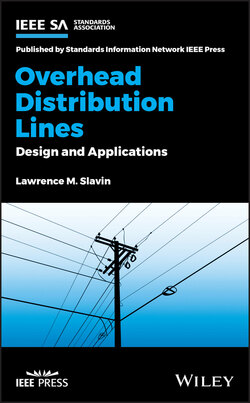Overhead Distribution Lines

Реклама. ООО «ЛитРес», ИНН: 7719571260.
Оглавление
Lawrence M. Slavin. Overhead Distribution Lines
Table of Contents
List of Tables
List of Illustrations
Guide
Pages
Overhead Distribution Lines. Design and Application
About the Author
Preface
Acknowledgments
1 Introduction. 1.1 Scope
1.2 Background
2 Pole Structures. 2.1 General
2.2 Wood Pole Strength
2.3 Loads
2.4 Embedment Depth
2.5 Guying
2.6 Column Buckling
2.7 Grounding and Bonding
Notes
3 Pole Installation and Maintenance. 3.1 Pole Placement
3.2 Guys and Anchors
3.3 Pole Maintenance
4 Wires, Conductors, and Cables. 4.1 Categories
4.2 Messenger Wire/Strand
4.3 Electric Supply (Power) Cables
4.4 Communications Cables
4.5 Wireless Attachments
5 Cable Installation. 5.1 Conductor and Cable Placement
5.2 Lashing Operation
5.3 Overlashing
Notes
6 NESC® Requirements (Strength and Loading)
6.1 National Electrical Safety Code (NESC)
6.2 Loading Requirements
6.3 Strength Requirements
6.4 Wire Tensions
6.5 Guyed Poles
6.6 Extreme Wind Loads (“60 ft Limit”)
6.7 Allowable Deterioration
6.8 Overlashed Cables
6.9 Software Tools and Pole Loading Analysis
Notes
7 NESC® Requirements (Clearances) 7.1 Clearances
7.2 Clearance Zones
7.3 Clearances Above Surfaces and Buildings
7.4 Clearances Between Wires
7.5 Overlashed Cables
Note
8 Principles of Wire Sag. 8.1 Catenary
8.2 Initial and Final Sag
8.3 Sag–Tension Relationship
8.4 Determining Change in Sag (and Tension)
8.5 Ruling Span
8.6 Point Load
Note
9 General Order 95 (California) 9.1 General Order 95 (GO 95)
9.2 Loading Requirements
9.3 Strength Requirements
9.4 Clearances
10 Examples. 10.1 Purpose
10.2 Tangent Line
10.3 Line Angle
10.4 Line Angle – Buckling Consideration
10.5 Additional Attachment
10.6 Summary
Note
Appendix A Properties of Messenger Strands
Appendix B Wireless Attachments
Appendix C Extreme Wind and Extreme Ice Loadings
Appendix D Solution of Cubic Equation
Note
Appendix E Point Load
E.1 Parabolic Model
E.2 Intersecting Straight Lines Model
Glossary
References
Index
WILEY END USER LICENSE AGREEMENT
Отрывок из книги
IEEE Press 445 Hoes Lane Piscataway, NJ 08854
IEEE Press Editorial Board Ekram Hossain, Editor in Chief
.....
Figure 1.1 Typical belowground construction.
Although not esthetically pleasing, the ubiquitous overhead lines throughout the United States – supported by possibly as many as 200 million utility poles – provide many important benefits, and is the reason these structures and suspended lines continue to be widely used. Individual distribution poles, or even lattice transmission towers, require minimum real estate at the ground level, and allow new lines to be readily deployed in available overhead space. This includes otherwise difficult crossing applications, or where expensive belowground construction methods (e.g. directional drilling) would be required, such as at highways, railroads, and waterways. Overhead installations avoid the many possible issues encountered when attempting to perform construction beneath the surface in various or unknown belowground conditions, often in the presence of existing belowground facilities. The latter situation can be particularly hazardous, especially when power or gas lines are in the vicinity. The use of mandatory “call-before-dig” rules, and related utility locating practices, are not infallible, and unfortunate accidents may occur in spite of such precautions.
.....